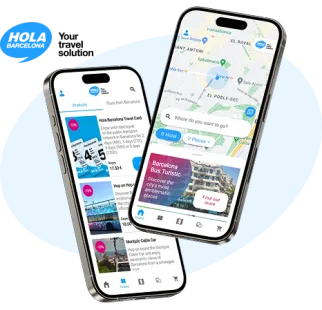Barcelona Pavilion
The building that marked the beginning of modern architecture in Barcelona
This building, designed by architect Ludwig Mies van der Rohe as the German national pavilion for the 1929 International Exposition, has inspired generations of architects and is considered the beginning of 20th-century modern architecture. Today, it can be admired again thanks to its reconstruction in the 1980s.

Montjuïc Cable Car, on the Hola Barcelona app
Your app for discovering the city from the heights with the Montjuïc Cable Car: journey, stops and most iconic places. A comfortable way to carry your tickets too!
A replica of a Weimar Republic building
The current building is a replica of the pavilion that represented progressive and democratic Germany during the Weimar Republic at the 1929 International Exposition in Barcelona. It was designed to host the official reception presided over by King Alfonso XIII alongside German authorities.
The pavilion embodies the German architect’s motto “less is more.” It features a complete fusion of spaces, aiming to eliminate the rigidity between interior and exterior. Built with glass, steel, and various types of marble, the building’s significance lies in the modern ideal expressed through the arrangement of these materials: perfect symmetry, open spaces, precise distances, and minimalism.
The effect is enhanced by Georg Kolbe’s sculpture Alba, strategically placed at one end of the pond. Inside the pavilion, you can also see the Barcelona chair, designed by Mies van der Rohe himself for the Pavilion. Made of leather and metal, it has become an icon of modern design.
Guided tours are available.
For the curious
- The pavilion is considered one of the four canonical works of modernist architecture, along with the Bauhaus building by Walter Gropius, Le Corbusier’s Villa Savoye, and Frank Lloyd Wright’s Fallingwater.
- The original pavilion was dismantled after the exposition in 1930, but as it became recognized as a key piece of 20th-century architecture, it was reconstructed in the 1980s on the same site, right next to the Magic Fountain.






